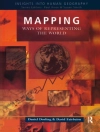This book presents the first single comprehensive analysis of the scope of geographical realities and relevance in health care work. Conceptually, the book conveys how space, place and geographical ideas matter to clinical practice, from the historical beginnings of professional roles and responsibilities in medicine to the present day. In 8 chapters, the book covers healthcare work across a range of job types (including physician, nurse, and multiple technical and therapeutic roles in multiple specialties), and across a range of scales (focusing on global issues and trends, national and regional particularities, urban and rural issues, institutional environments and various community settings). This book is intended for students, teachers, and researchers in geography, social science and various health sciences.
Chapter 1 examines how geographical ideas have been central to practitioners’ thinking and practice over time. Chapter 2 reviews the scope of contemporary geographical study of health care work. Chapter 3 presents an empirical case study of the geographies in hospital-based ward work. Chapter 4 presents an empirical case study of the geographies in ambulance/rapid response work. Chapter 5 presents a case study of the geographies associated with a high profile case of criminality and neglect in practice. Chapter 6 considers concepts and the geographies in person-centred care. Chapter 7 considers concepts and the geographies in skills attainment.قائمة المحتويات
Part1. Introductions.- Chapter1. The geographical origins of geographical thinking on health care work.- Chapter2. The geographical turn in contemporary health professional research: contexts, motivators, current and emerging perspectives.- Part2. Exemplars.- Chapter3. Case study I: Hospital-based multidisciplinary work – institutional emotional geographies.- Chapter4. Case study II:Care on the move – the emotional geographies of ambulance crews.- Chapter5. Case study III: Safe, ethical professionals? Trust and the representation of nurses, work and places in the context of neglectful and dangerous practice.- Part3. Visions .- Chapter6. Towards a research agenda that progresses key debates: example I – unpacking more-than-human assemblages of person-centred care.- Chapter7. Towards a research agenda that progresses key debates: example II – animating emerging ‘skilling space’.
عن المؤلف
Gavin J. Andrews, BA, Ph D is a Professor at the Department of Health, Aging and Society, Mc Master University, Canada (and an Associate member of the Department of Geography and Earth Sciences at the same institution). As a health geographer, his wide-ranging interests including the dynamics between space/place and: health care education and work, nursing, holistic medicine, aging and fitness cultures. Much of his work is positional and considers the development, state-of-the-art and future of health geography. In recent years, he has become interested in the potential of posthumanism and non-representational theory in conveying the vital ‘taking place’ of health and healthcare.
Emma Rowland, BA, Ph D is a Lecturer at the Florence Nightingale Faculty of Nursing and Midwifery, King’s College London, United Kingdom. She is a Geographer with an interest in both emotional and health geographies. Her work focuses on how space, place, temporality and ideas of proximity and distance within secondary care settings (hospital and ambulance service), impact on health professionals’ emotion management, relationships with each other and their patients and on their delivery of patient care. Her current scholarly activities focus on the emotion management, specifically emotion work of partners with a spouse affected by hereditary breast cancer.
Elizabeth Peter, RN, Ph D is a Professor at the Lawrence S. Bloomberg Faculty of Nursing and a member of the Joint Centre for Bioethics and the Centre for Critical Qualitative Health Research, University of Toronto, Canada. Her scholarship reflects her interdisciplinary background in nursing, philosophy and bioethics. Drawing on the work of human geographers, she has used geographical concepts to examine the unique ethical concerns that arise in the delivery of home and community services. She has also explored the spatial dimensions of moral distress in nursing that arise as a result of nurses’ proximity to patients.












